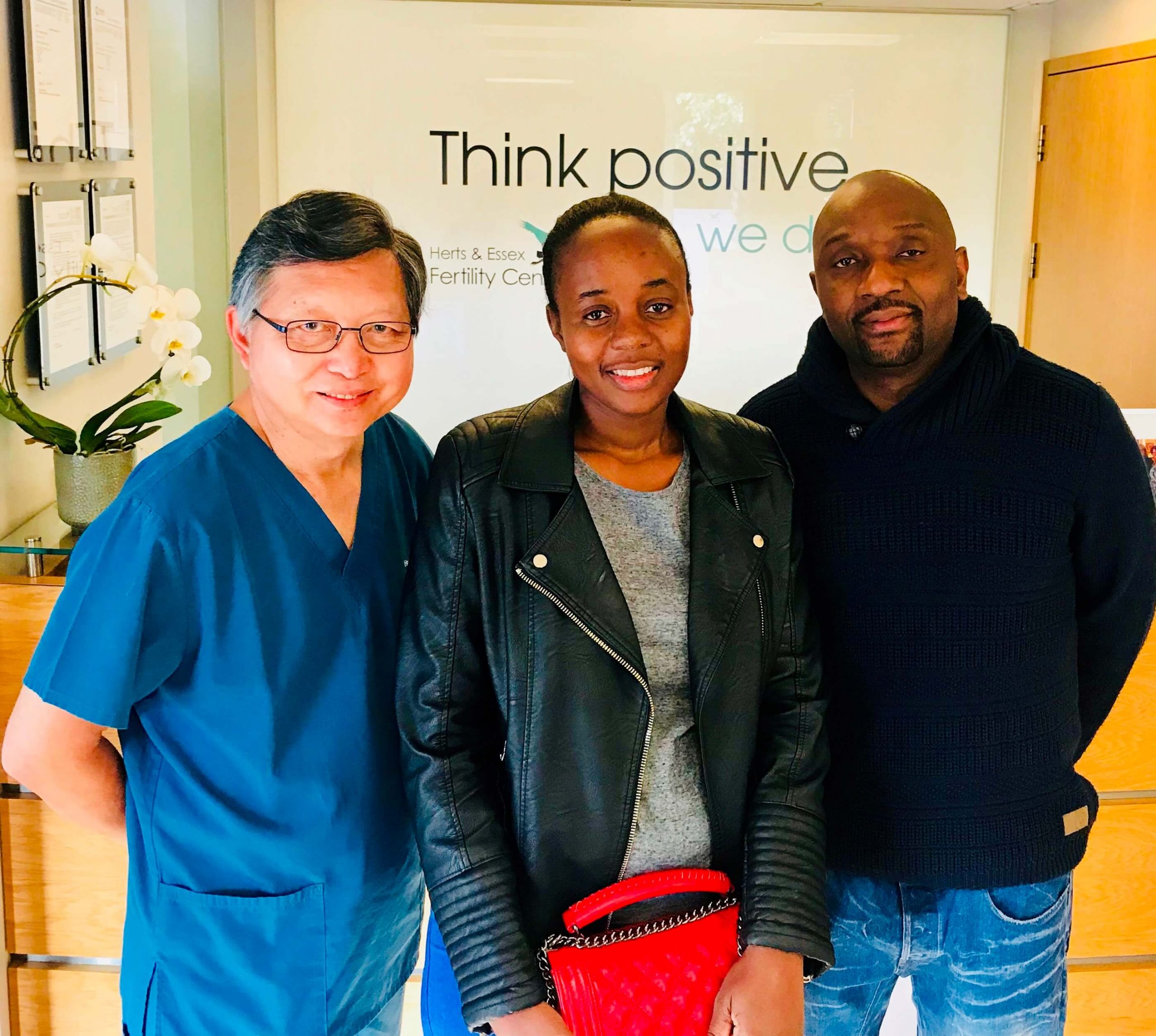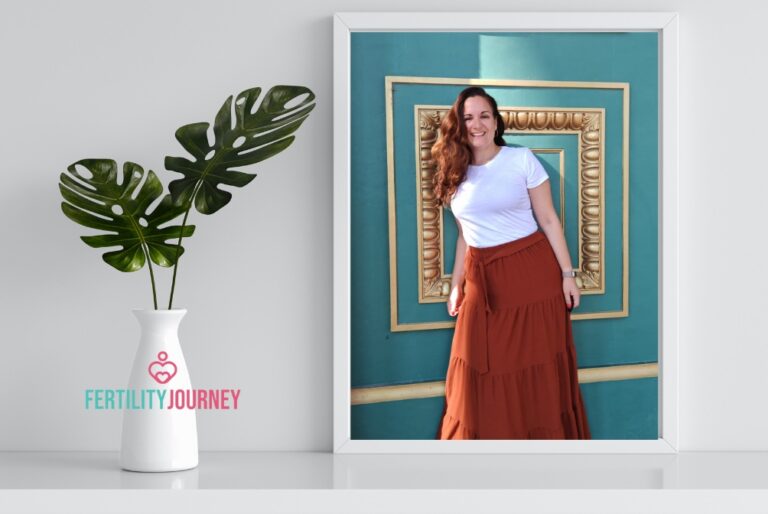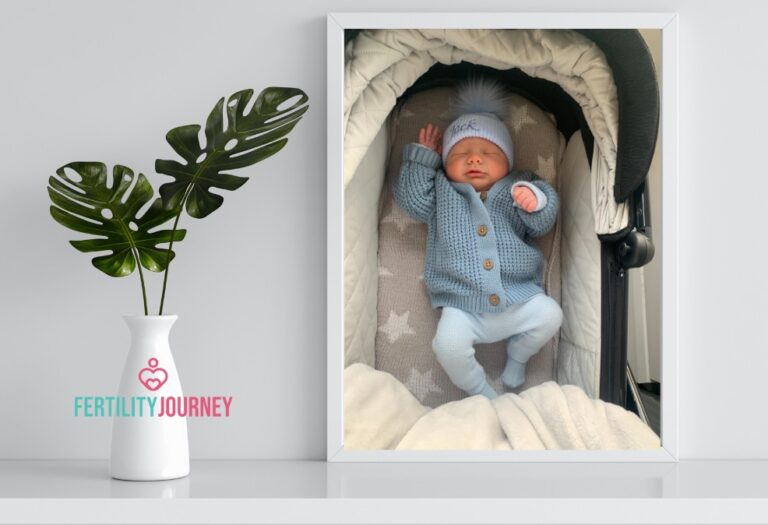Following their initial consultation with our Consultant gynaecologist, Mr Michael Ah-Moye and a detailed information appointment with the fertility nurse, Yvonne had a 3D ultrasound scan and saline infusion sonogram at the beginning of November with our Consultant gynaecologist, Mr David Ogutu.
The purpose of the detailed scan was to investigate her uterus, fallopian tubes and ovaries in preparation for their ICSI cycles. Factors that may impair their chances of successful conception or increase the risk of a miscarriage are assessed. During the procedure, her egg reserve (antral follicle count) was also determined. The egg reserve assessment enables us to accurately and safely determine the best dose to stimulate, optimising egg yield while at the same time ensuring a low risk of ovarian hyperstimulation (producing too many eggs which may have health implications for Yvonne).
The scan confirmed an above average egg reserve. However, on her left side, the fallopian tube was found to be blocked and filled with fluid (hydrosalpinx). She also has a single large fibroid (a benign uterine growth).
The hydrosalpinx and fibroids would lower her chances of successful ICSI. She has also been experiencing pain symptoms from these lesions. Following discussions to include the advantages and disadvantages of surgical removal of tube and fibroids, as well as the risks involved, they opted to have surgery before continuing with their treatment.
Removal of the hydrosalpinx is likely to double their chances of success compared to going ahead with treatment without surgery. Yvonne will have keyhole surgery (laparoscopic surgery) through four 0.5 – 1 cm cuts in the abdomen to remove the fibroid as well as the damaged fallopian tube. She will have an overnight stay in the hospital and her ICSI cycle will commence 6 weeks later.
Reproductive surgery to improve fertility outcomes
One in seven couples has difficulty conceiving in the UK. One third of cases are due to female factors, one third due to male factors and one third due to a combination of male and female factors.
In the UK, the treatment endpoint for half of all couples is in vitro fertilisation (IVF) or intracytoplasmic sperm injection (ICSI). The other half conceive spontaneously or through intrauterine insemination. A minority will adopt a child, or not have any treatment at all. Among those with female factors infertility, management options include lifestyle changes such as weight loss, stopping smoking, ovulation induction or surgical treatments to aid conception.
Several conditions affect the uterus, ovaries as well as the fallopian tubes. These would lower the chances of conceiving, increase the risk of miscarriage or risk of preterm premature delivery. Thankfully, most of these conditions are amenable to surgery. Surgical procedures result in spontaneous conceptions in many cases. Where patients require intrauterine insemination (IUI) / IVF / ICSI, surgery optimises the chances of a live birth. With most of these conditions managed as day surgery or office procedures using keyhole surgery, recovery is much quicker with very low complication rates, as opposed to open surgery. Women are also able to start trying to conceive again / start their fertility treatment within a few weeks of the procedure.
Uterine conditions
Endometrial polyps
Endometrial polyps are benign growths that occupy the uterine cavity. They lower the chances of getting pregnant and increase the risk of miscarriage. Removal is performed by a keyhole procedure, known as hysteroscopy.
Uterine fibroids
Uterine fibroids could also grow into the cavity of the womb and are known as submucous fibroids. These benign growths are amenable to hysteroscopic removal. There is very strong scientific evidence that polyps and submucous fibroids lower the chances of a live birth and surgical removal significantly improves the
live birth rates.
Uterine fibroids could also grow within the wall of the womb (intramural fibroids) or grow outwards from the womb (subserous fibroids). Intramural fibroids when large would lower live
birth rates. The effect of surgery is not very clear but depends on the size and location of the intramural as well as subserous fibroids.
Uterine cavity scarring (Asherman’s syndrome)
Uterine cavity could get scarred by previous surgical procedures, womb infections, retained placenta etc. The scarred cavity has a lower chance of implantation. Hysteroscopy and repair of the scarring resolves the condition in most cases.
Uterine septum
During the development of a baby within its mother’s womb, the uterus starts off as two structures that join in the midline. The joining wall gradually disappears resulting in one womb cavity. In some females, this middle wall does not disappear, resulting in a uterine septum, a wall dividing the womb cavity into two separate chambers.
Uterine septum is more often seen among women having difficulties conceiving and those who have suffered repeated miscarriages. They are also associated with premature delivery and abnormal baby position at birth (breech or transverse presentation).
At the Herts and Essex Fertility Centre, all patients have a 3D ultrasound scan to screen for this as well as other abnormal uterine structural defects that may lower the chances of a live birth. There is very good evidence that a simple day surgery keyhole procedure, hysteroscopic resection of the uterine septum improves live birth rates. Where confirmed, we have the expertise and experience to resolve these abnormalities and we have very good outcomes data. The National Institute of Health and Care Excellence (NICE) in their 2015 guidelines recommends that surgery should be offered and discussed to women with infertility and recurrent pregnancy loss found to have a uterine septum.
Tubal conditions
Blocked fallopian tubes
Fallopian tubes transport eggs and sperm, nourish the two and enable their fertilisation. The initial five days of the fertilised eggs’ (embryos’) development takes place within the fallopian tube
before being transported into the uterine cavity for
implantation.
Fallopian tubes could be damaged and blocked by infections, endometriosis (abnormal uterine lining cells growing outside the womb), previous appendicitis complications among others.
Where the damage or blockage is not too severe, keyhole surgery could be used to repair and reopen the blockage. However, in cases of irreversible blockage, the tubes will occasionally fill up with fluid. This is known as a hydrosalpinx.
Hydrosalpinx
This is a fallopian tube that is blocked and filled up with fluid. The hydrosalpinx is usually visible on an ultrasound scan. There is very good evidence that hydrosalpinx significantly lowers the probability of successful conception and also increases the risk of a miscarriage. It is thought that the fluid in
the tubes tracks back into the uterus and could physically flush out an embryo from the womb. The noxious material from the hydrosalpinx fluid could also affect the developing embryo.
For women having IVF/ICSI, removal of the damaged tube (salpingectomy) or clipping the tube to prevent the fluid from entering the uterine cavity doubles the chances of a live birth. This is again performed through a day surgery keyhole procedure (laparoscopy) with very quick recovery, with the IVF treatment starting as soon as a month later.
Endometriosis and ovarian cysts
Endometriosis is a condition in which cells from the uterine cavity lining ( endometrial cells) end up in the pelvis, outside the womb, develop a blood supply and develop into ovarian cysts, (endometriosis
cyst or endometrioma), cause scarring, matting of abdominal and pelvic organs, block fallopian tube etc.
They could have no symptoms, or present with painful periods, pain during sexual intercourse, pain when opening bowels etc. They are a common cause for tubal blockage as well. Depending on the structures involved, laparoscopic surgery may be necessary to enable spontaneous conception, especially in a young woman with mild to moderate endometriosis as well as to improve the chances of success for IVF.
Most ovarian cysts found in women undergoing fertility investigations or treatments are benign. The vast majority will resolve spontaneously without the need for medical intervention. However, some may require surgical removal and the vast majority can be removed by keyhole surgery as a day case.
Conclusion
A detailed assessment as a one-stop service ensures prompt diagnosis and management to optimise the chances of a live birth in the shortest possible time.
At Herts and Essex Fertility Centre, all patients have a detailed 3D saline infusion sonogram, a detailed assessment of the uterus, its walls, the fallopian tubes, ovaries and surrounding pelvic structures. Where abnormalities are detected, prompt expert management with minimally invasive surgical procedures where necessary optimises the chances of a spontaneous conception, and where required, significantly improves the IVF / ICSI success rates.




